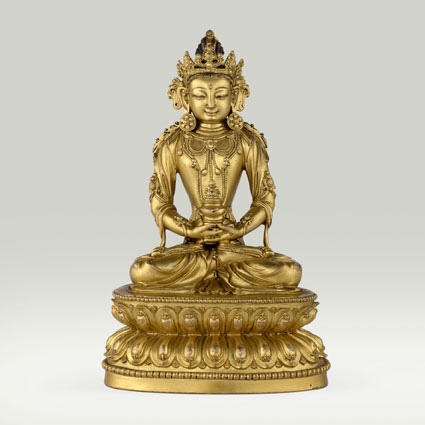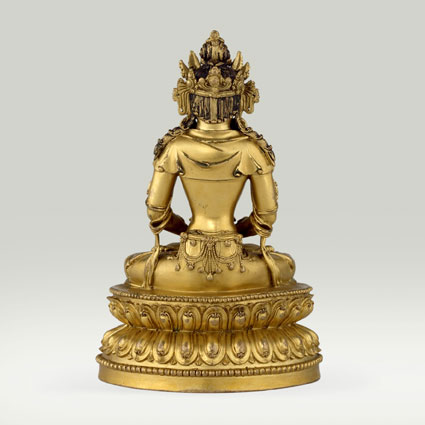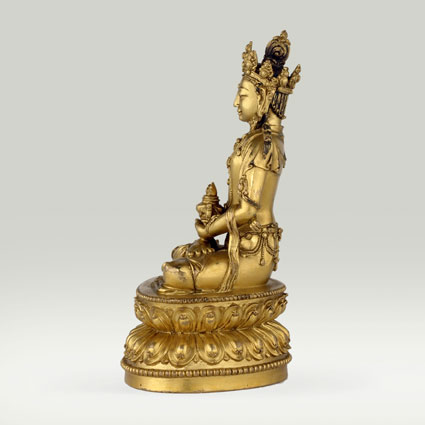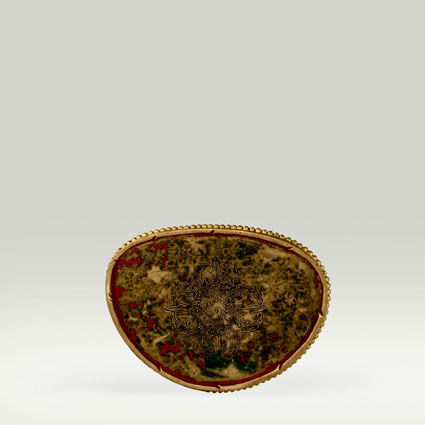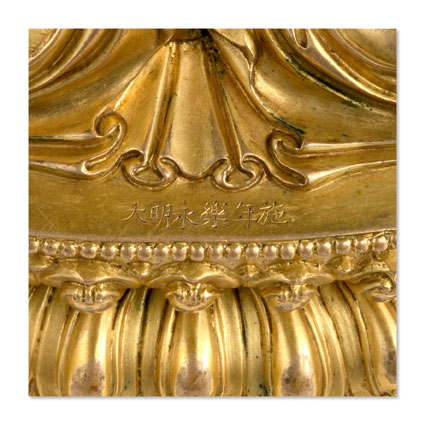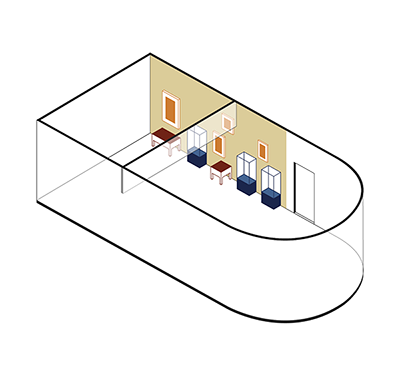ABS 114
Code: ABS 114
Country: China
Style: Ming Dynasty - Yongle Period
Date: 1403 - 1424
Dimensions in cm WxHxD: 9.7 x 15.3 x 7.2
Materials: Gilt copper
The bottom of the pedestal is sealed with a red painted sheet of brass decorated with a visvavajra emblem.
The jewelled and crowned form of Amitayus (Tib. Tshe dpag med) is seated in the diamond attitude (vajraparyanka) on a double lotus pedestal with beaded borders. With the hands in the gesture of meditation (dhyana mudra), he holds a water-pot filled with the elixir of immortality (kalasa). Amitayus is clad with a cloth (dhoti) tied around the waist and a ribbon-like scarf is placed over the shoulders and falls down over the arms to the pedestal. He wears princely ornaments, namely a five fold crown in front of the knot of hair (jatamukuta) with a jeweled tip, a pair of circular earrings, two necklaces with attached pendants, and ornaments at the upper arms, wrists, ankles and feet.
The top of the pedestal is inscribed with the six character Yongle mark: “Da Ming Yongle nian shi”.
A crowned image of Buddha displaying the dhyana mudra is usually identified as Amitabha (Tib. ’Od dpag med) and if holding a kalasa named Amitayus.
Then the Bhagavat addressed the honored Shariputra and said, "O Shariputra, after you have passed from here over a hundred thousand kotis of Buddha countries there is in the Western part a Buddha country, a world called Sukhatvati (the happy country). And there a Tathagata, called Amitayus, an Arhat, fully enlightened, dwells now, and remains, and supports himself, and teaches the Dharma.
"Now what do you think, Shariputra, for what reason is that world called Sukhavati (the happy)? In that world of Sukhavati, O Shariputra, there is neither bodily nor mental pain for living beings. The sources of happiness are innumerable there. For that reason, is that world called Sukhavati (the happy).
"And again, O Shariputra, that world Sukhavati is adorned with seven terraces, with seven rows of palm-trees, and with strings of bells. It is enclosed on every side, beautiful, brilliant with the four gems, viz. gold, silver, beryl and crystal. With such arrays of excellences peculiar to a Buddha country is that Buddha country adorned."
"And again, O Shariputra, when those rows of palm trees and strings of bells in that Buddha country are moved by the wind, a sweet and enrapturing sound proceeds from them. Yes, O Shariputra, as from a heavenly musical instrument consisting of a hundred thousand kotis of sounds, when played by Aryas, a sweet and enrapturing sound proceeds, a sweet and captivating sound proceeds from those rows of palm-trees and strings of bells moved by the wind. And when the men hear the sound, reflection on the Buddha arises in them, reflection on the Dharma arises in them, reflection on the Sangha arises in them."
"And what do you think, O Shariputra, for what reason is that Tathagata called Amitayus? The length of life (=ayus), O Shariputra, of that Tathagata and of those men there is immeasurable (amita). Therefore, is that Tathagata called Amitayus. And ten kalpas have passed, O Shariputra, since that Tathagata awoke to perfect knowledge."
"Then again, all beings, O Shariputra, ought to make fervent prayers for that Buddha country. And why? Because they come together there with such excellent men. Beings are not born in that Buddha country of the Tathagata Amitayus as a reward and result of good works performed in this present life. No, whatever son or daughter of a family shall hear the name of the blessed Amitayus, the Tathagata, and having heard it, shall keep it in mind, and with thoughts undisturbed shall keep it in mind for one, two, three, four, five, six or seven nights -- when that son or daughter of a family comes to die, then that Amitayus, the Tathagata, surrounded by an assembly of disciples and followed by a host of Bodhisattvas, will stand before them at their hour of death, and they will depart this life with tranquil minds. After their death they will be born in the world Sukhavati, in the Buddha country of the same Amitayus, the Tathagata."
The Five Buddha Families
The essential nature of a bodhisattva or a buddha is that he or she embraces the enlightened qualities of the five buddha families, which pervade every living being without exception, including ourselves.
To achieve the realization of these five buddha families or the five dhyana buddhas, it is necessary to abandon the five disturbing emotions of great attachment, anger or aggression, ignorance or bewilderment, pride and envy. When these disturbing emotions are purified and removed, the five wisdoms shine forth. Realization of the five wisdoms is realization of the five dhyana buddhas. To begin with, we have to understand what the five disturbing emotions (Skt. kleshas) are.
1. The first, which seems to be most powerful, is anger. Anger is an emotion which arises and develops against someone or something one dislikes. If examined carefully, in the short run anger creates pain and in the long run it brings about serious harm. The immediate pain and future harm is to oneself as well as to others is due to the power of one’s own aggression. We therefore need to understand the first negative emotion. The negative emotion of anger causes temporary suffering for oneself and others for this lifetime. This emotion is so powerful that all negative actions or karma accumulated by wishing harm to others can lead one to take rebirth in the lower realms. For example, intense anger can cause rebirth in the lowest hell realm where there is intense suffering. Therefore, anger not only causes suffering and pain in this lifetime, but also causes us to take birth in the lower realms, where even more intense suffering ensues as a result. To be free of the experience of suffering and pain in this lifetime and to be free of the experience of taking birth in a lower realm, it is necessary to employ methods to overcome and eliminate anger and hatred.
When anger is purified and removed, we come to develop and to gradually realize mirror-like wisdom. With mirror-like The Five Buddha Families and the Eight Consciousnesses wisdom, there is no distinction between self and others, there is no separation between self and other phenomena, so everything is experienced in unity and harmony. It is called mirror-like wisdom because phenomena appear to the mind in the same way that things appear in a clean mirror, completely accurate with no distortion. Understanding and realizing mirror-like wisdom takes place in the absence of the negative emotion of anger. Realization of mirror-like wisdom is realization of Buddha Akshobhya, who is blue in color. He holds a vajra in his left hand. His activity is pacifying the emotions, in particular, suffering, illness, frustration, and sorrow.
2. The second dhyana Buddha is the Buddha Ratnasambhava who is realized when the disturbing emotion of pride or ego is purified. Ego is the belief in a self which we all develop from birth as soon as our mind thinks of itself as separate from others. The next three types of pride evolve in this process of selfcenteredness: (1) We feel that we are better than others who are in a less fortunate situation, (2) we feel that we are superior to others because we fail to see the equality of ourself and others; and (3) we feel we are either spiritually or materially better than others. What causes us to embark upon the journey of ego? When the self believes that it is separate from others, the negative emotion of pride arises in which one believes oneself in some way better than others. From this then arises the belief that there are “good” i.e. things which we believe in and do and “bad” i.e. things that others believe in and do. As long as we believe ourselves to be superior to others, it is impossible to learn from them. So we must give up ego clinging to develop enlightened qualities. A purified mind does not distinguish between pure and impure, good and bad, I and others; rather it experiences all things in equality. When one is free from pride, realization of the wisdom of equality dawns and one experiences and becomes Buddha Ratnasambhava.
Buddha Ratnasambhava’s activity is enriching and as a symbol of his activity of enrichment, he is gold or yellow in color. As a symbol of his ability to enrich all living beings, he holds the precious wish-fulfilling jewel in his hands.
3. The third dhyana Buddha represents the purification and elimination of the disturbing emotion of attachment or desire. Desire causes much suffering by being quite distracting and keeping the mind restless and busy. Why? When one is attached to things, one is never satisfied and always craves for more and better things. One is continuously engaged in achieving and acquiring the mind’s desires and only experiences loss and dissatisfaction in one’s life. By understanding this negative emotion and by eliminating it, the third discerning wisdom shines forth. By realizing discerning wisdom, the enlightened mind is experienced, and one becomes one with the Buddha Amitabha. It is with this wisdom that one understands and has empathy with each and every living being and appreciates others’ qualities.
The Buddha Amitabha’s nature is the absence of attachment and desire and his activity is magnetizing. As already said, attachment and desire lead to the suffering of dissatisfaction, a state in which one always wants and strives for more and better things. Desire determines one’s behavior and not attaining what one desires leads to frustration and dissatisfaction. With the discerning wisdom and the realization of Buddha Amitabha, there is no attachment and desire and thus no dissatisfaction or craving for more and better things. This realization is so powerful that all things are naturally magnetized as one’s own. There is no energy and force involved as in a state of desire.
4. The fourth dhyana Buddha is Buddha Amogasiddha. He is realized in the absence of the negative emotion of jealousy which includes being jealous of others’ wealth, success, and good fortune. With jealousy negativity is accumulated. By overcoming jealousy, Amogasiddha and the fourth all accomplishing wisdom are realized. Jealousy prevents and impedes an individual from accomplishing his or her own well-being and as a result he or she experiences more suffering and continues developing further jealousy towards those who have more. This is the reason all accomplishing wisdom is experienced in the absence of jealousy, i.e., when jealousy is removed, all wishes are naturally and effortlessly accomplished. As long as jealousy determines one’s attitude, one is bound to experience more obstacles in achieving personal success and in accomplishing positive goals.
This is why Buddha Amogasiddha’s activity is wrathful. It is with wrath that he removes all obstacles and hindrances preventing spiritual maturation and success. He is green in color, the same color as growing plants symbolizing the numerous activities he employs to remove hindrances.
5. The fifth dhyana Buddha is Buddha Vairocana, who is realized when the negative emotion of ignorance is overcome. Ignorance is failing to recognize what is wholesome and unwholesome, failing to know the ultimate and conventional truth and failing to realize the highest state of dharmata. Ignorance is the root of the negative emotions, so that, for example, it is only out of ignorance that one is angry. One only acts aggressively towards others because one is ignorant that anger will only bring on pain and sorrow to oneself and others. Likewise, it is only due to ignorance that one has pride, desire, and jealousy.
Elimination of the darkness of ignorance is the realization of Buddha Vairocana. The wisdom which shines forth when ignorance is overcome is the wisdom of dharmata, i.e., realization of the highest state. We have failed to realize the true state up until now due to ignorance, and this ignorance causes all the mental confusion and misleading actions. Purification of ignorance engenders realization of the wisdom which sees all things as they really are. The natural body of the purity of the wisdom of dharmata is Buddha Vairocana. Since the darkness of ignorance is eliminated, he is the clear color of white.
Qualities Arising from Transforming Negative Emotions
We have given a brief description of the five dhyana buddhas who represent the purified qualities of the five disturbing emotions. When these five negative emotions are purified, the qualities of the five buddhas shine forth purely.
Amitayus is considered the samboghakaya form of Amitabha. In Tibetan, he is called Tse-pameh. The scripture describing him is The Shorter [or Lesser] Sukhavati Text (Skt. Sukhavati-viyuha) and in it we are given the key to understanding the true nature of deities in Buddhism.
Tse.pag.med (pron. Tse-pa-meh or cheh-pah-meh) is depicted holding a flask of amrita, the nectar of immortality which confers longevity. Often an ashok [anti-suffering] tree grows from the vase looking something like a heap of raspberries or a cluster of grapes.
Buddha Amitabha
The third dhyana buddha is Amitabha who represents the purification of desire also called attachment. When we are under the influence of attachment, we discriminate between good and bad, beautiful and ugly, and then we cling to what seems to be attractive and shun those things which seem bad or ugly. Attachment and aversion are disturbing emotions that arise from not understanding the nature of things as they are and as they appear. It is due to ignorance that mind accepts and rejects objects of attachment and aversion. With the wisdom of discrimination, one knows things as they appear just as they are without any confused and prejudiced opinions. This comes about by purifying attachment and realizing Buddha Amitabha. Buddha Amitabha is the Sanskrit name and the Tibetan name is
sangay odpamed, which means “boundless light.” When one has developed the awareness of knowing everything as it manifests, one has developed the clarity of boundless light, which is completely free from confusion. This realization is described as odpamed or “boundless light.” We can compare this state with an example of a lamp. A faulty lamp cannot illuminate a room clearly, whereas a perfect lamp can allow us to see things distinctly and clearly. The light of Buddha Amitabha is therefore
boundless and is realized through the purification of attachment and desire.
Buddha Amitabha is of the lotus family because a lotus grows in muddy water while its blossoms remain stainless. Likewise, Amitabha represents freedom from attachment, and it is attachment which causes us to experience pain, loss, and dissatisfaction that never finds fulfillment. Purification of the negative emotion of attachment is a state of immaculate, pure peace. Therefore, the Buddha Amitabha is seated in the full vajra posture and both hands resting in the meditative posture of mental clarity. He fully understands things as they are and as they appear without subjective notions. This state is one of peace and ease. He resides in the buddha realm of Dewachen.
Beer, Robert, 2010. Die Symbole des tibetischen Buddhismus. München : Diederichs. S. 331-332
Bock, Etienne; Falcombello, Jean-Marc; Jenny Magali, 2022. Trésors du Tibet. Sur les pas de Milarépa.. Paris: Flammarion. p. 105
Chandra, Lokesh, 1986. Buddhist Iconography of Tibet (CBIT). Rinsen Book Co.. Mongolian bKa ’gyur [1–510], p. 96, no. 87; Narthang Pantheon [511–1009], pp. 264–5, no. 689, 691; Astasahasrika Pantheon [1082–2203], p. 552, no. 1685; Three Hundred Icons (sKu brnyan sum brgya) [2206–2503], pp. 712–13, nos. 2285(82), 2288 (85) - References to the iconography of the crowned Amitayus holding a kalasa
Chandra, Lokesh, 1986. Buddhist Iconography of Tibet (CBIT). Rinsen Book Co.. Mongolian bKa ’gyur [1–510], p. 95, no. 84: Uncrowned Buddha in dhyana mudra holding a kalasa; Narthang Pantheon [511–1009], p. 264, no. 688: Uncrowned Buddha in dhyana mudra holding a patra - References to the iconography of the uncrowned Nirmanakaya Amitayus
Khenchen Thrangu, 1998. The Five Buddha Families and the Eight Consciousnesses. Boulder: Namo Buddha Seminar . Namo Buddha Seminar 1390 Kalmia Avenue Boulder, CO, 80304-1318 USA Tel.: (303) 449-6608 Email: cjohnson@ix.netcom.com Rinpoche’s web site: www.rinpoche.com - References to the iconography of the uncrowned Nirmanakaya Amitayus
von Schroeder, Ulrich, 2001. Buddhist Sculptures in Tibet. Vol. One: India & Nepal; Vol. Two: Tibet & China. Hong Kong: Visual Dharma Publications, Ltd.. Pp. 1280-81, pl. 358E - Compare
von Schroeder, Ulrich, 2006. Empowered Masters: Tibetan wall paintings of Mahasiddhas at Gyantse. Chicago: Serindia Publications ; and Hong Kong: Visual Dharma Publications, Ltd.,. Pp. 23-24
von Schroeder, Ulrich, 2010. Buddhist Sculptures of the Alain Bordier Foundation. Hong Kong: Visual Dharma Publications, Ltd.. p. 52-53; plate 23A

